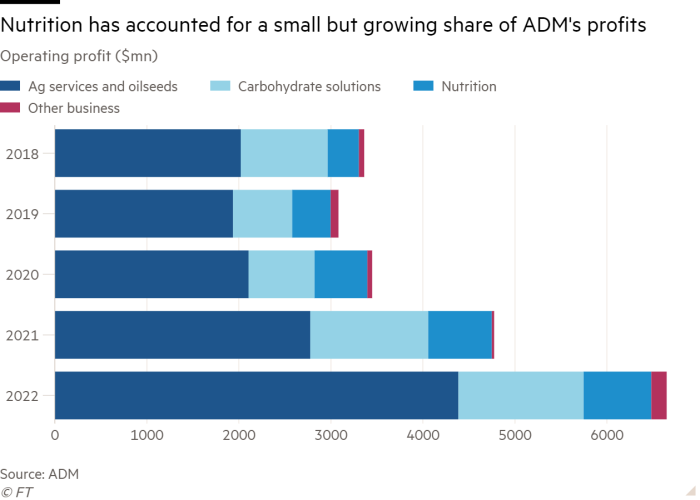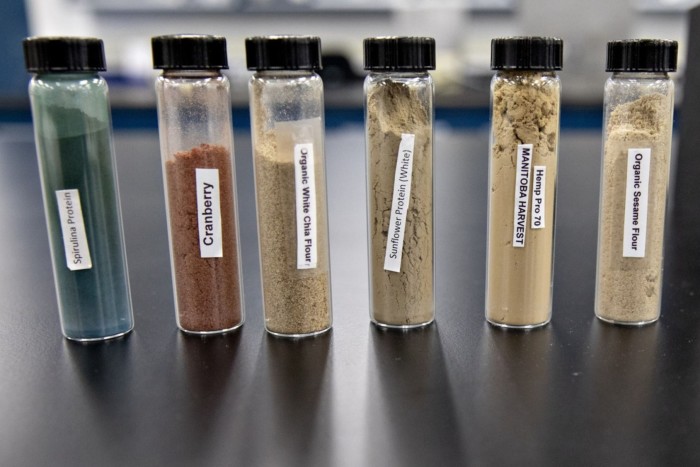
Unlock the Editor’s Digest for free
Roula Khalaf, Editor of the FT, selects her favourite stories in this weekly newsletter.
Archer Daniels Midland aggressively expanded into nutrition and food ingredients in 2014, aiming to build a hedge against the volatility of the commodity trader’s other businesses and shore up its income stream.
A decade later, the nutrition business has plunged one of the world’s largest agricultural trading houses into turmoil.
The Chicago-based company’s shares plummeted 24 per cent on Monday, their largest one-day decline since 1929, after announcing that chief financial officer Vikram Luthar had been put on leave amid an investigation into the accounting practices and procedures of the nutrition business. Ismael Roig had been appointed CFO on an interim basis, according to a statement published late on Sunday.
ADM is a low-profile company that plays a pivotal role in global food supplies, buying crops from farmers for processing into bulk ingredients, animal feed and motor fuel or shipping to customers around the world. Founded in 1902, it is the A in the so-called ABCD of global food commodities traders, along with Bunge and Cargill from the US and Louis Dreyfus in Europe. The business is volatile and typically operates on razor-thin margins, driven as much by the size of harvests and government policies as corporate management and strategy.
Under chief executive Juan Luciano, ADM sought to diversify into the lower-volume but higher-profit-margin nutrition business, supplying flavours, probiotics and other ingredients to industries including plant-based meats and pet food.
This week’s news “damages ADM’s growth strategy, it damages their credibility and their plan to shift away from just creating merchandising and crop trading into this more stable, higher profit nutrition business”, said Seth Goldstein, analyst at Morningstar Investment Service.

ADM said it had launched the probe after a request for documents from the US Securities and Exchange Commission. The company also said the release of its fourth-quarter earnings would be delayed as a result of the investigation, and revised down its expectations for annual adjusted earnings per share from $7 to $6.90.
Goldstein said the revised guidance suggested a 40 per cent decline in nutrition profits from 2022, “ and that’s even assuming we can trust the 2022 numbers”. The market reaction this week is an indication that it “has lost confidence in [ADM’s nutrition] story”, Goldstein added. ADM declined to comment.
Just over two years ago, the company set a target for doubling profits from its nutrition segment to between $1.2bn and $1.5bn by 2025. “Aggressive, yes; doable, yes,” Vincent Macciocchi, who headed the division until 2022, said during ADM’s global investor day in December 2021. “I tell our team all the time, this is the opportunity of our careers to build the world’s leading nutrition business inside of a Fortune 100 company, and there’s never been a better time to be at ADM.”

ADM’s purchase of Wild Flavors, a Switzerland-based ingredients manufacturer, for €2.3bn ($3.1) in 2014 remains the largest acquisition in company history. The move led to the creation of a new division that has continued to grow with more deals, including for French animal feed maker Neovia for €1.5bn ($1.8bn) in 2018 and dairy flavours maker Revela Foods along with UK-based ingredients producer FDL last year.
The Covid-19 pandemic and Russia’s full-scale invasion of Ukraine, a big grain and oilseed exporter, pushed up food prices and worsened rates of hunger in many parts of the world but drove price swings that led to record profits for agricultural traders. ADM reported more than $100bn in revenue in 2022.
The bulk of this came from ADM’s trading-heavy agricultural services and oilseeds business, but the nutrition segment benefited too. As prices of animal feed crops rose, for example, demand grew for certain types of proteins, such as amino acids, used as supplements in feed mixes.
The traders’ overall profits slipped from their record highs last year as price volatility eased. The small wins for ADM’s nutrition arm were also shortlived.
In 2022, the nutrition division’s operating profit grew by just 6.5 per cent, a far cry from double-digit growth rates touted by Luciano a few years ago. The share of total operating profit from nutrition fell in the first nine months of 2023, to 10 per cent, as ADM has struggled amid waning demand for plant-based protein.

Investors have never been convinced of the nutrition segment’s value, said Dushyant Ailani, an analyst at Jefferies. While ADM’s management was “pretty optimistic about it”, he said, for investors “it’s always been a show-me story . . . if you can show consistent performance within the segment, then we’ll give you credit for it”. The investigation will not help, he added.
Goldstein disagreed. The reason the stock sold off so much, despite the nutrition arm being a relatively small part of ADM’s business, was because the market had been “giving ADM some credit for moving into a more stable, higher-profit, downstream nutrition business”.
But the accounting investigation and decision to put Luthar on leave suggested “that the growth wasn’t there”, said Goldstein. “ADM wasn’t ever able to grow the nutrition business and diversify from grain merchandising as quickly as it appeared.”
